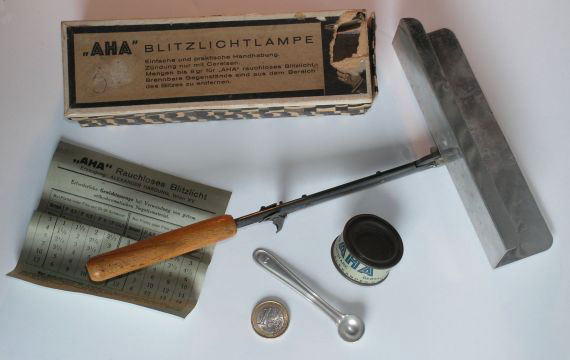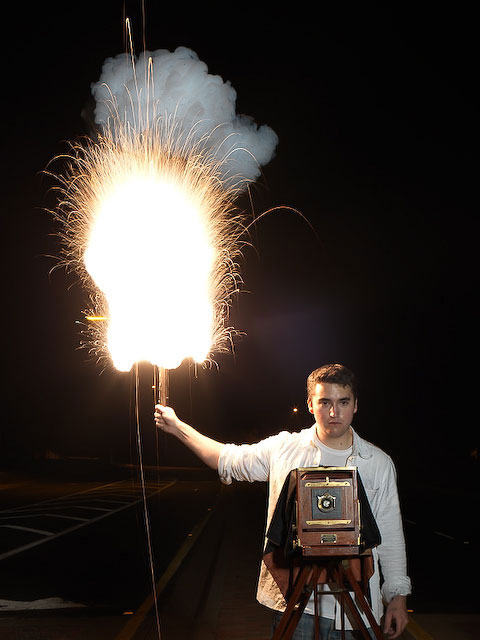The history of Flash - from dynamite to light-emitting diodes
Starting from the beginning of photography, photographers have created artificial light sources to make the image bright and beautiful as desired in many different ways.
The birth history of Flash
In this article, we will go from the pristine flash - explosive powder to the modernity of LED Light Emitting (LED) technology.
1. Explosive powder
You must have seen the photographer in black and white movies holding a tray in the past and it exploded when they took pictures, creating a loud noise and dazzling light. This flash photography technique burns chemicals to create artificial light sources, making the image bright enough.

Explosive powders include metal powders (magnesium or aluminum) and oxidizing agents (usually chloride) mixed together. When this mixture burns, it produces a strong light source in a very short time. Before being used for photography, explosive powder is often used on theater and in fireworks.
However, manual detonation is a very dangerous task, which can cause the photographer to be injured if not careful. Therefore, a safer solution was invented in 1899.
2. Flash using explosive powder
Inventor Joshua Lionel Cowen and photographer Paul Boyer presented a safer solution of explosive powder at the end of the 20th century. This flash has a groove to hold explosive powder, electrically detonated by a battery. dried.

This light is activated with the camera's shutter button, which helps the light source be emitted at the time the shutter is open. In addition, it can be mounted on a tripod and activates multiple lights at the same time to create the desired light.
Although this invention is safer than using direct detergent powder, it is still dangerous compared to current safety standards. Many photographers in the past suffered injuries, even deaths, when using these lamps. Fortunately, another invention erased the photographers' fears.
3. Flash elected
In 1927, General Electric Corporation produced the first elected flash lights. Instead of burning explosive powder in the air, the flash bulb creates a light source by activating the filament made of magnesium and containing oxygen in the ball. Originally, the light bulb was made of glass but then replaced with plastic because the glass ball was easily broken due to pressure in the lamp.

Ironically, a minor problem is that the flash bulb is too fragile to break and can only be used once. Moreover, it often causes burns if not careful after being used.

Even so, the gourd flash has a very interesting point that it takes a while since it is activated to achieve maximum brightness and its brightness is much longer than today's flash. The old photographers used to activate the flash first, then press the shutter button to get the picture correct.
4. Flash block

Having to change the flash every time a photo is taken really annoys the photographer. So Kodak has released a block flash flash containing 4 flash balls used once in the 1960s. The way this flash works is similar to flash, but it is more convenient to have this flash shot available. You can rotate the flash block to use another flash ball. Many improvements and enhancements to this flash format are released because of its convenience.
5. Electronic flash
Although convenient with block flashes, the flash that the photographers really needed was a flash that could be used many times without having to replace it. Harold Egerton - electrical professor - studied and released electronic flash at the end of the 19th century.

Electronic flash uses a capacitor to store electricity. When activated, the energy from the capacitor passes through a flash of glass that contains gas in a vacuum, creating a strong light source in a short time. Outstanding advantages such as excellent flash sync speed, repeated use, superior durability, short charging time make the flash ball use hair to go into the past.

Currently, the advantages of electronic flash have made us use it anywhere, from the studio to the outside. The flash of electric flashes usually contains xenon gas and has a very high durability compared to the electronic flash type in the past.
With the continuous development of technology, the current flash can be hit at the same time without necessarily connecting to the camera with wires. What's more, high-speed flash can now be brightly lit in extremely short time, helping photographers master the lighting better.
6. LED flash

Unless you own Nokia 1020, most other smartphones use LED flash. Flash LED is not as powerful as xenon flash, but consumes very little power and extremely small size - perfect for today's smartphones. Big companies like Apple, HTC and Nokia have developed 2-color LED flash on their phones to help capture human skin more accurately.
And that's the whole history of flash, from explosive powder to LED technology.
- The father of the LED complained that he was forgotten
- Can flash light cause infant blindness?
- Successfully manufactured the smallest organic light emitting device
- How important is a positive blue LED for Nobel Prize 2014?
- OLED bulbs - lighting equipment in the future
- Japanese scientist won the 2014 Nobel Prize in Physics
- The lightning flashes x dangerous from the sun
- Eliminate red-eye effect and make animated images with Photoscape
- Enhance the performance of UV LEDs with zinc oxide microfiber
- World's smallest LED flash light
- High tech tattoo from ultra-thin graphene
- Aero Swf Max Flash Player An indispensable tool for flash
 'Fine laughs' - Scary and painful torture in ancient times
'Fine laughs' - Scary and painful torture in ancient times The sequence of numbers 142857 of the Egyptian pyramids is known as the strangest number in the world - Why?
The sequence of numbers 142857 of the Egyptian pyramids is known as the strangest number in the world - Why? History of the iron
History of the iron What is alum?
What is alum?